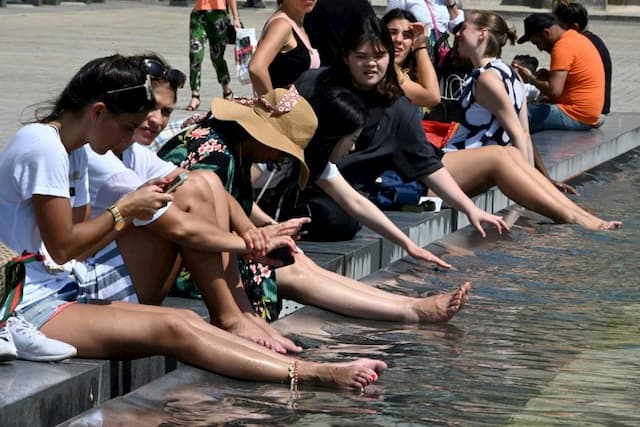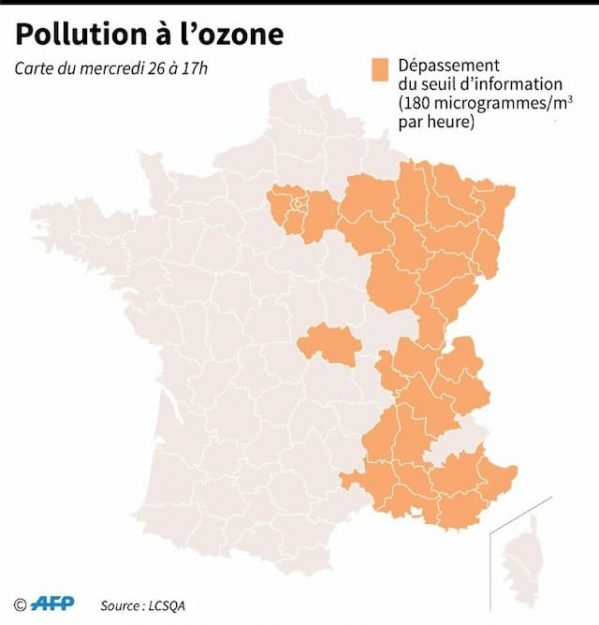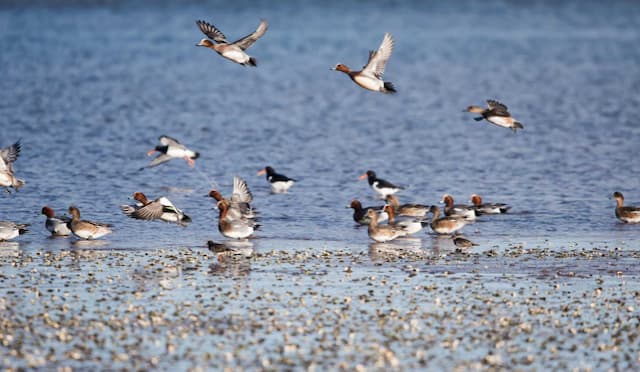Heat Wave: 78 Departments in Orange Alert, “Difficult” Days Ahead

This Wednesday 26th June 2019, the day before the peak of the heat wave, it is up to 40 ° C in the shade and the orange alert has been extended to three-quarters of the country.
The heat is still rising a notch Wednesday, June 26, 19 19 in France, on the eve of the expected peak of the heat wave, and the differentiated traffic was set up in Paris and Lyon in the face of pollution related to the furnace.
It is now 78 departments that are placed in an orange alert by Météo France, during its last weather report at 16h Wednesday. The heat wave extends to the south and west, reaching almost the entire Atlantic seaboard. Only the departments of Hauts-de-France, Calvados, Manche, Côtes d’Armor and Finistère remain completely spared (in green on the map).
🔶 78 dpts en #vigilanceOrange
Restez informés sur https://t.co/rJ24zzmmy4 pic.twitter.com/sjuB4537rR
— VigiMétéoFrance (@VigiMeteoFrance) 26 June 2019
The departments that were added to the vigilance orange on Wednesday at 16h are: Ariège (09), Aude (11), Bouches-du-Rhône (13), Charente-Maritime (17), Southern Corsica (2A), Upper Corsica (2B), Gard (30), Gers (32), Hérault (34), Ille-et-Vilaine (35), Loire-Atlantique (44), Var (83) and Vendée (85).
Will Record be beaten on Friday?
For the first time since the beginning of this exceptional heat wave for a month of June, the 40 ° C bar was crossed this Wednesday, with 40.6 ° C in Peyrolles-en-Provence (Bouches-du-Rhône), 40 , 5 ° C at Montclus (Gard) and 40 ° C at Apt (Vaucluse).
But this episode, which is likely to be repeated due to global warming, will continue to grow and continue until at least the weekend.
Thus, if Meteo France was forecasting 38 and 40 ° C from the Southwest to the Massif Central and Provence Wednesday afternoon, the mercury is expected to climb Thursday with 38 to 41 ° C expected in the regions south of the Loire.
And for Friday afternoon, the forecasting body announces “exceptional temperatures” in the lower Rhone valley, often between 42 and 44 ° C.
Thus, “Friday, we can beat the national record locally,” told AFP forecaster Christelle Robert. The French maximum date of August 12th 2003 with 44.1 ° C recorded in Saint-Christol-lès-Ales and Conqueyrac, in the Gard.
The situation should improve Saturday in the south-east, but not in the Paris region that will live its hottest day (between 38 and 40 ° C). “It will be necessary to wait until at least until Tuesday to see the whole country to find lower temperatures, but which should remain above normal season,” warned Météo-France in its latest bulletin.
⚠️ La vague de #Chaleur s’accentue dans les prochains jours (cartes températures prévues mercredi, jeudi et vendredi). #VigilanceOrange Restez vigilants https://t.co/KA0Ij27Eea pic.twitter.com/nFjvdcmGBS
— VigiMétéoFrance (@VigiMeteoFrance) 25 June 2019

“The next three days will be difficult” for hospitals that are seeing their activity increase because of the heat wave, said Wednesday the Minister of Health, Agnes Buzyn, visiting Moselle . “We feel that with the hot days that accumulate in many departments, the organizations begin to suffer and calls increase,” she added.
#Canicule2019 : les nuits à venir s’annoncent tropicales et donc étouffantes, notamment dans les villes avec le phénomène d’îlot urbain ! Nos explications 👉https://t.co/BjrDOQuple pic.twitter.com/Ic92GyijqG
— La Chaîne Météo (@lachainemeteo) 25 June 2019
Differentiated circulation
This heat wave is accompanied by ozone pollution in part of the country, from Ile-de-France to the Grand-Est and Rhône-Alpes. This classic episode of heat waves – ozone forming by chemical reactions between other pollutants, under the effect of the sun – led to the establishment of differentiated traffic Wednesday in Paris, Lyon and Annecy . Thursday, these restrictions will be renewed in Ile-de-France, in Lyon, and will start in Marseille for the first time, and in Strasbourg.

In the Paris region, only vehicles equipped with a Crit’Air sticker class 0, 1 and 2 are allowed to circulate within the perimeter defined by the A86, Paris and the small crown. Other vehicles, petrol cars registered before the end of 2005 and diesel registered before the end of 2010 (vignettes Crit’Air 4, 5 but also now 3), are prohibited. A measure that concerns 1/3 of Parisian vehicles and much more in Ile-de-France.
“I learned from a previous episode of pollution in the winter, when we saw that by putting the vignettes Crit’air 0, 1, 2, and 3 it had almost no effect, so we tightened up, “commented Minister of Ecological Transition François de Rugy on RMC on Wednesday.
✋Stationnement résidentiel gratuit & circulation différenciée en ce mercredi 26 juin, de 5h30 à minuit.#canicule #pollution https://t.co/d6ee1SWMBX
➡️ Circulation différenciée: seuls les véhicules classés Crit’air 0, 1 et 2 pourront circuler dans l’agglomération parisienne.
— Paris (@Paris) 26 June 2019
The mayor of Paris Anne Hidalgo announced in a statement that “a specific package ‘peak pollution’ will be available on the network of public transport in Ile-de-France so that Parisians and visitors can easily access public transport.”
Some schools closed
If the coming days will be hot, the nights will not allow organisms to recover with temperatures that will not go below 20 to 24 ° C for example in the night from Wednesday to Thursday, according to Meteo France.
On the night of Tuesday to Wednesday, minimum temperature records for June have already been recorded in Nice (26 ° C) or Alistro (Upper Corsica, 25.6 ° C).
On Monday, the government announced the postponement of a few days of college patent tests, scheduled for Thursday and Friday, to “ensure the safety of students.” Some communes have announced the closure of their schools on Thursday and Friday, but most prefer to ask parents to keep children “if they can,” while ensuring the reception of students.
“I want them (schools) to be as open as possible, but in extreme cases, we have to close. This is a decision that is made locally, with local officials, “said Education Minister Jean-Michel Blanquer on Cnews.
Everywhere we organize
Meanwhile, this heat pushes the inhabitants to look for the dark corners. Television and radio broadcast messages of caution relayed in transport and on billboards.
Everywhere we organize, including for the spectators and teams of the Women’s World Cup: messages of caution to the first, special drinks for the seconds.
Farmers must be vigilant for the health of their animals. Others fear that drought will affect fodder.
For SNCF and RATP, this heat involves closely monitoring equipment and infrastructure, including power cables, catenaries and tracks.
In the building industry representatives announced the shift in the hours of workers.
Cafetiers, on the other hand, smile, with a foreseeable increase in turnover of at least 30%.
With global warming, scientists anticipate heat waves two to three times more numerous by mid-century.
This heat wave from the Sahara brings back the memory of the August 2003 episode, which had generated excess mortality of 15,000 people over more than 15 days (more than 70,000 in Europe). This is an episode unprecedented in its intensity and precocity since 1947 and the establishment of detailed records, says Meteo France.
#Canicule2019 : actualisation de nos cartes pour le pic de #chaleur 📈🌡️ pic.twitter.com/GGcruFPgCt
— La Chaîne Météo (@lachainemeteo) 25 June 2019
Enjoyed this? Get the week’s top France stories
One email every Sunday. Unsubscribe anytime.


